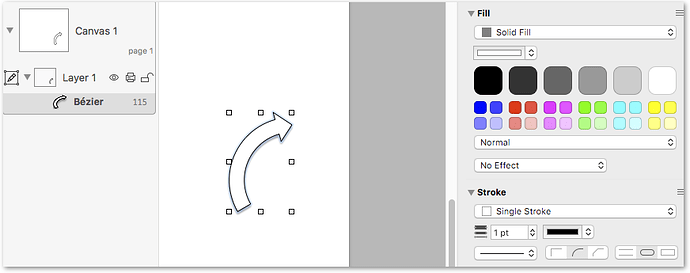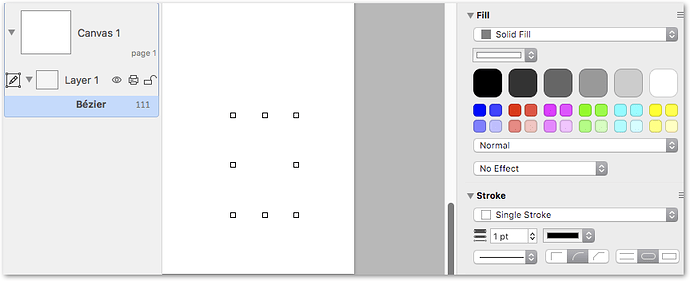Perhaps this is by design, but it took a bit of debugging to understand why Bezier shapes were vanishing from the canvas, though still displayed in the outline sidebar, and it seems like a possible analogue of the property setting order bugs that have now been fixed with text and magnet properties.
i.e.
.shape = 'Bezier'
if fine if set before
.shapeVertices = ...
but turns out to be (perhaps unexpectedly ?) destructive if it follows the supply of the vertices.
If we start out with this:
.shape = 'Bezier'
will leave us with this:
(If the .shape property had not been specified before the .shapeVertices were)
You can experiment with the setting sequence permutations of .shape and .shapeVertices in the code below.
The pattern seems to be:
.shapeVertices on its own is OK ( the .shape getter will then respond with ‘Bezier’)
.shape then .shapeVertices is OK,
.shape then .shapeVertices then .shape again is also OK,
BUT
.shapeVertices then .shape (not previously specified) turns out to be destructive …
(() => {
'use strict';
// log :: a -> IO ()
const log = (...args) =>
console.log(
args
.map(JSON.stringify)
.join(' -> ')
);
// show :: Int -> a -> Indented String
// show :: a -> String
const show = (...x) =>
JSON.stringify.apply(
null, x.length > 1 ? [x[1], null, x[0]] : x
);
var g1 = Object.assign(
document.windows[0].selection.canvas.newShape(),
{
'geometry' : new Rect(290.57, 235.28, 83.60, 132.03),
//'shape':'Bezier',
'shapeVertices': [new Point(385.33, 384.31), new Point(382.58, 379.13), new Point(380.20, 373.78), new Point(378.20, 368.27), new Point(376.59, 362.63), new Point(375.38, 356.89), new Point(374.57, 351.09), new Point(374.17, 345.24), new Point(374.19, 339.37), new Point(374.61, 333.53), new Point(375.44, 327.72), new Point(376.68, 321.99), new Point(378.31, 316.36), new Point(380.34, 310.86), new Point(382.74, 305.52), new Point(385.52, 300.35), new Point(388.65, 295.39), new Point(392.12, 290.67), new Point(395.91, 286.20), new Point(400.00, 282.00), new Point(404.38, 278.10), new Point(409.03, 274.52), new Point(413.91, 271.27), new Point(419.00, 268.38), new Point(424.29, 265.84), new Point(429.74, 263.69), new Point(435.33, 261.92), new Point(432.65, 252.28), new Point(457.77, 268.85), new Point(443.38, 290.82), new Point(440.70, 281.18), new Point(436.44, 282.53), new Point(432.29, 284.17), new Point(428.27, 286.10), new Point(424.39, 288.30), new Point(420.68, 290.77), new Point(417.15, 293.50), new Point(413.82, 296.47), new Point(410.70, 299.66), new Point(407.82, 303.06), new Point(405.18, 306.66), new Point(402.80, 310.43), new Point(400.68, 314.36), new Point(398.85, 318.43), new Point(397.31, 322.61), new Point(396.07, 326.89), new Point(395.13, 331.26), new Point(394.49, 335.67), new Point(394.17, 340.12), new Point(394.16, 344.58), new Point(394.47, 349.03), new Point(395.08, 353.45), new Point(396.00, 357.81), new Point(397.23, 362.10), new Point(398.75, 366.30), new Point(400.56, 370.37), new Point(402.65, 374.31)],
'shape':'Bezier'
}
);
log('g1 ', g1.constructor.name );
log('g1.shapeVertices.length', g1.shapeVertices.length);
return show(
['x','y','width','height'].map(k => g1.geometry[k])
);
})();
Or, a simpler test example – with a rectangle:
(() => {
'use strict';
// log :: a -> IO ()
const log = (...args) =>
console.log(
args
.map(JSON.stringify)
.join(' -> ')
);
// CREATE A SIMPLE RECTANGLE ---------------------------------------------
var
canvas = document.windows[0].selection.canvas,
g = canvas.newShape();
g.geometry = new Rect(203.21, 155.91, 64.77, 58.66);
// CACHE THE RECTANGLE'S SHAPE VERTICES
// ( in case they are deleted unintentionally )
var points = g.shapeVertices;
log('BEFORE', 'g.shapeVertices', g.shapeVertices);
// REDEFINE THE RECTANGLE AS A BEZIER SHAPE ------------------------------
g.shape = 'Bezier'
// Its .shapeVertices have now been unexpectedly DELETED,
// and the rectangle is left invisible on the canvas
log('AFTER', 'g.shapeVertices', g.shapeVertices);
// Unless we restore the points which we may or may not have cached ...
// UNCOMMENT THE FOLLOWING
// FOR A VERSION WHICH RESTORES THE RECTANGLE TO VISIBILITY:
// g.shapeVertices = points
})();


